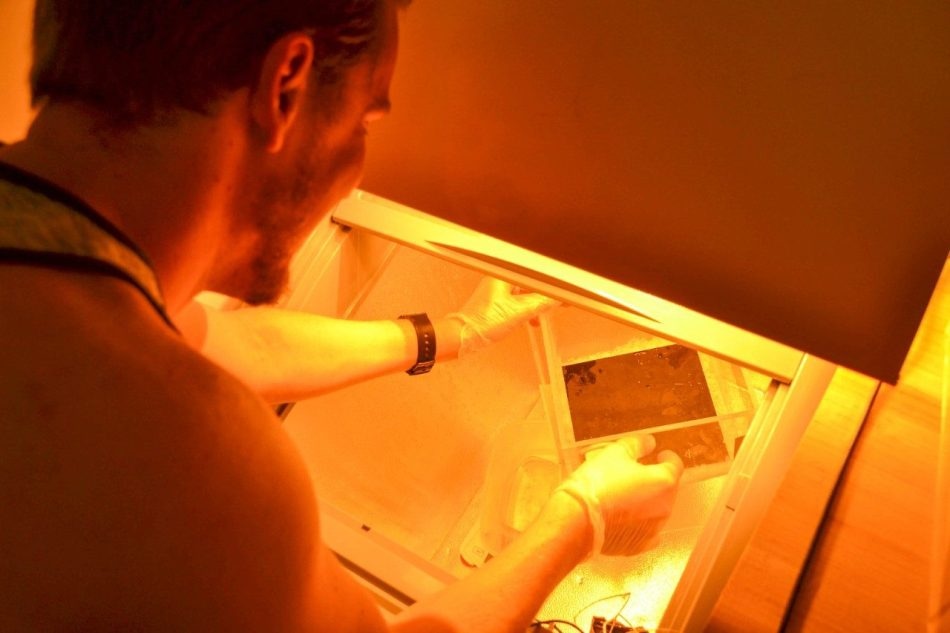Feb 19 2018
Reminders of a snowstorm can be seen for days – sometimes weeks – after warmer and sunnier weather returns. Snowbanks, often formed by snow plows as they clear major roadways can stay on sidewalks, in parking lots, and in driveways even when temperatures rise above freezing.
 Karl Vitale positions a scale model of the Melt Mat, a type of thermal absorptive blanket, inside an experimental set up equipped with artificial sunlight that allowed students to monitor the rate of snowmelt over time. Vitale belonged to an undergraduate senior project team in the Department of Biomedical Engineering and Mechanics that designed, constructed, and tested the Melt Mat, which accelerates snow melting times by threefold. (Image credit: Virginia Tech)
Karl Vitale positions a scale model of the Melt Mat, a type of thermal absorptive blanket, inside an experimental set up equipped with artificial sunlight that allowed students to monitor the rate of snowmelt over time. Vitale belonged to an undergraduate senior project team in the Department of Biomedical Engineering and Mechanics that designed, constructed, and tested the Melt Mat, which accelerates snow melting times by threefold. (Image credit: Virginia Tech)
Fresh snow’s extremely reflective surface is the cause of this phenomenon, greatly reducing any potential melting effects from the sun’s heat. Cities in cold regions usually resort to active approaches to remove snowbanks, such as using gas-powered heaters or hauling the snow to disposal sites. These efforts can chalk up an annual bill anywhere in the range of $25 million to $125 million per city, making snow removal a perpetual problem.
A Virginia Tech, undergraduate student research team has discovered the solution - the Melt Mat. It is applicable for municipalities aiming to save millions as well as for homeowners hoping to avoid snow shovel duty.
The product of a senior design team in the Department of Biomedical Engineering and Mechanics within the College of Engineering, the Melt Mat is a thermally absorptive blanket developed from a thin sheet of aluminum that has been spray-coated with an ultra-flat black paint. When draped over snow, the Melt Mat increases the melting time by threefold, all without any energy input or effort.
The results of the students’ Melt Mat design, fabrication, and testing research can be found in the journal Langmuir. The student researchers have also been granted a provisional patent for the Melt Mat through Virginia Tech Intellectual Properties.
The idea for a thermal absorptive blanket is novel, but also very practical. For novelty's sake, the team really needed to go for a journal publication. For practicality's sake, we went for a patent.
They ended up getting both. I was very proud of them.
Jonathan Boreyko, Assistant Professor of Biomedical Engineering and Mechanics
Senior design teams are a hallmark of the engineering science and mechanics undergraduate program. They form in the spring of students' junior year. During this time, program faculty members visit junior classes on a rotating schedule to put forth their ideas for senior projects. After choosing an idea, team members become engrossed in the design project until graduation – occasionally longer – with the aim of conducting research and designing products together with their faculty advisors.
Generally, snow reflects about three-quarters of the sun's radiation back into the air, so it's actually really hard for the sun to melt a snowbank,. Even if temperatures are above freezing and the sun is out, the snow's surface just bounces most of the heat right off. That's the fundamental problem we're trying to address here.
Jonathan Boreyko, Assistant Professor of Biomedical Engineering and Mechanics
In spring 2016, Boreyko pitched the idea for a thermal absorptive blanket, something that would not only absorb the sun's heat but could also conduct that heat across the blanket's surface to speed up snow melting times. After choosing Boreyko's idea as the focus of their project, the team then started the process of designing, building, and experimenting with several scale models, one of which would emerge as the Melt Mat over a year later.
The Melt Mat’s simple, passive design means it would not be expensive to make and suitable for repeated use. Its durable construction also prevents the Melt Mat from degrading over time, an issue noticed with other passive techniques of snow removal, such as spreading large quantities of soot particles over snowbanks for a similar effect. Since the Melt Mat does not depend on antifreeze or other chemicals that could run off into groundwater, its use has no negative effects on the environment.
With a broad array of applications – including parking lots, residential driveways and sidewalks, and athletic fields – several design team members investigated the possibility of starting a company to manufacture, market, and sell the Melt Mat. But currently, with their provisional patent in hand, the team is hoping to find a well-known company that might be keen to work toward a full patent, which could allow for licensing agreements to use the Melt Mat's technology.
"When our senior design class had concluded, we felt like we were really on to something," said Sarah Wray, a senior design team member and one of the study's co-authors. "We decided to push ourselves further."
With any luck, the Melt Mat may soon arrive at stores.
Supplementary co-authors and senior design team members include Owen Hansen, Andrew Sheen, Kristen Swedberg, Karl Vitale, and Matthew Fox, all of whom are 2017 engineering science and mechanics graduates from Virginia Tech’s undergraduate program.